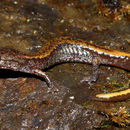en
names in breadcrumbs


The Larch Mountain salamander (Plethodon larselli) is a species of salamander in the family Plethodontidae endemic to the United States. It occurs in the Cascade Mountains of southern Washington and northern Oregon. In Washington, it occurs from the Columbia River Gorge to just north of Snoqualmie Pass. Its natural habitats are temperate forests and rocky areas. It is threatened by habitat loss.[1]
The Larch Mountain salamander was originally described as a species by D.M. Burns in 1962. Originally considered a subspecies of Van Dyke's salamander, the Larch Mountain salamander's closest genetic relative is the Jemez Mountains salamander, endemic to New Mexico.[2]
The Larch Mountain salamander is a small, terrestrial salamander. The species is characterized by a variable dorsal stripe, typically orange, light brown, or yellow, which is often blotchy. The ground color is brown, with light speckling in certain areas. This species is easily distinguishable from other western Plethodon by its reddish-salmonish venter. Adults are typically just smaller than 2 inches in snout-to-vent length, with a mode of 15 costal grooves.[3]
The Larch Mountain salamander (Plethodon larselli) is a species of salamander in the family Plethodontidae endemic to the United States. It occurs in the Cascade Mountains of southern Washington and northern Oregon. In Washington, it occurs from the Columbia River Gorge to just north of Snoqualmie Pass. Its natural habitats are temperate forests and rocky areas. It is threatened by habitat loss.
Plethodon larselli Plethodon generoko animalia da. Anfibioen barruko Plethodontidae familian sailkatuta dago, Caudata ordenan.
Plethodon larselli Plethodon generoko animalia da. Anfibioen barruko Plethodontidae familian sailkatuta dago, Caudata ordenan.
Plethodon larselli est une espèce d'urodèles de la famille des Plethodontidae[1].
Cette espèce est endémique du Nord-Ouest Pacifique. Elle se rencontre dans le comté de Skamania dans l'État de Washington et dans les comtés de Hood River et de Multnomah en Oregon[1].
Cette espèce est nommée en l'honneur d'Olof Larsell (1886-1964)[2].
Plethodon larselli est une espèce d'urodèles de la famille des Plethodontidae.
Plethodon larselli é uma espécie de salamandra da família Plethodontidae.
É endémica da Cordilheira das Cascatas do Noroeste Pacífico, do oeste da América do Norte.
Os seus habitats naturais são: florestas temperadas e áreas rochosas.
Está ameaçada por perda de habitat.
Plethodon larselli é uma espécie de salamandra da família Plethodontidae.
É endémica da Cordilheira das Cascatas do Noroeste Pacífico, do oeste da América do Norte.
Os seus habitats naturais são: florestas temperadas e áreas rochosas.
Está ameaçada por perda de habitat.
Plethodon larselli (tên tiếng Anh: Larch Mountain Salamander) là một loài kỳ giông trong họ Plethodontidae. Nó là loài đặc hữu của Hoa Kỳ. Các môi trường sống tự nhiên của chúng là các khu rừng ôn hòa và vùng nhiều đá. Nó bị đe dọa do mất môi trường sống.
Plethodon larselli (tên tiếng Anh: Larch Mountain Salamander) là một loài kỳ giông trong họ Plethodontidae. Nó là loài đặc hữu của Hoa Kỳ. Các môi trường sống tự nhiên của chúng là các khu rừng ôn hòa và vùng nhiều đá. Nó bị đe dọa do mất môi trường sống.